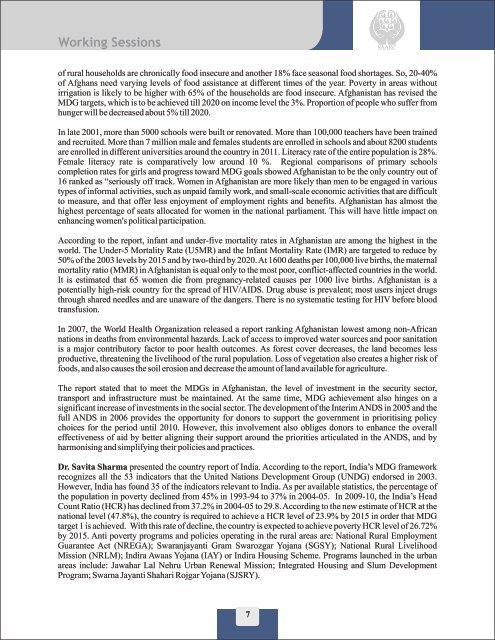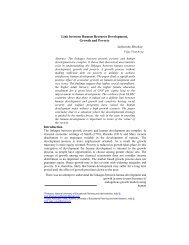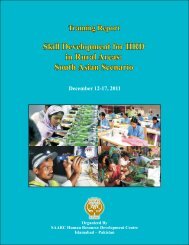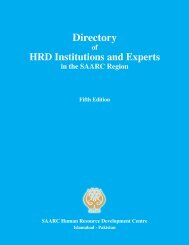Training Report: Millennium Development Goals in the SAARC Region
Training Report: Millennium Development Goals in the SAARC Region
Training Report: Millennium Development Goals in the SAARC Region
You also want an ePaper? Increase the reach of your titles
YUMPU automatically turns print PDFs into web optimized ePapers that Google loves.
Work<strong>in</strong>g Sessions<br />
of rural households are chronically food <strong>in</strong>secure and ano<strong>the</strong>r 18% face seasonal food shortages. So, 20-40%<br />
of Afghans need vary<strong>in</strong>g levels of food assistance at different times of <strong>the</strong> year. Poverty <strong>in</strong> areas without<br />
irrigation is likely to be higher with 65% of <strong>the</strong> households are food <strong>in</strong>secure. Afghanistan has revised <strong>the</strong><br />
MDG targets, which is to be achieved till 2020 on <strong>in</strong>come level <strong>the</strong> 3%. Proportion of people who suffer from<br />
hunger will be decreased about 5% till 2020.<br />
In late 2001, more than 5000 schools were built or renovated. More than 100,000 teachers have been tra<strong>in</strong>ed<br />
and recruited. More than 7 million male and females students are enrolled <strong>in</strong> schools and about 8200 students<br />
are enrolled <strong>in</strong> different universities around <strong>the</strong> country <strong>in</strong> 2011. Literacy rate of <strong>the</strong> entire population is 28%.<br />
Female literacy rate is comparatively low around 10 %. <strong>Region</strong>al comparisons of primary schools<br />
completion rates for girls and progress toward MDG goals showed Afghanistan to be <strong>the</strong> only country out of<br />
16 ranked as “seriously off track. Women <strong>in</strong> Afghanistan are more likely than men to be engaged <strong>in</strong> various<br />
types of <strong>in</strong>formal activities, such as unpaid family work, and small-scale economic activities that are difficult<br />
to measure, and that offer less enjoyment of employment rights and benefits. Afghanistan has almost <strong>the</strong><br />
highest percentage of seats allocated for women <strong>in</strong> <strong>the</strong> national parliament. This will have little impact on<br />
enhanc<strong>in</strong>g women's political participation.<br />
Accord<strong>in</strong>g to <strong>the</strong> report, <strong>in</strong>fant and under-five mortality rates <strong>in</strong> Afghanistan are among <strong>the</strong> highest <strong>in</strong> <strong>the</strong><br />
world. The Under-5 Mortality Rate (U5MR) and <strong>the</strong> Infant Mortality Rate (IMR) are targeted to reduce by<br />
50% of <strong>the</strong> 2003 levels by 2015 and by two-third by 2020. At 1600 deaths per 100,000 live births, <strong>the</strong> maternal<br />
mortality ratio (MMR) <strong>in</strong> Afghanistan is equal only to <strong>the</strong> most poor, conflict-affected countries <strong>in</strong> <strong>the</strong> world.<br />
It is estimated that 65 women die from pregnancy-related causes per 1000 live births. Afghanistan is a<br />
potentially high-risk country for <strong>the</strong> spread of HIV/AIDS. Drug abuse is prevalent; most users <strong>in</strong>ject drugs<br />
through shared needles and are unaware of <strong>the</strong> dangers. There is no systematic test<strong>in</strong>g for HIV before blood<br />
transfusion.<br />
In 2007, <strong>the</strong> World Health Organization released a report rank<strong>in</strong>g Afghanistan lowest among non-African<br />
nations <strong>in</strong> deaths from environmental hazards. Lack of access to improved water sources and poor sanitation<br />
is a major contributory factor to poor health outcomes. As forest cover decreases, <strong>the</strong> land becomes less<br />
productive, threaten<strong>in</strong>g <strong>the</strong> livelihood of <strong>the</strong> rural population. Loss of vegetation also creates a higher risk of<br />
foods, and also causes <strong>the</strong> soil erosion and decrease <strong>the</strong> amount of land available for agriculture.<br />
The report stated that to meet <strong>the</strong> MDGs <strong>in</strong> Afghanistan, <strong>the</strong> level of <strong>in</strong>vestment <strong>in</strong> <strong>the</strong> security sector,<br />
transport and <strong>in</strong>frastructure must be ma<strong>in</strong>ta<strong>in</strong>ed. At <strong>the</strong> same time, MDG achievement also h<strong>in</strong>ges on a<br />
significant <strong>in</strong>crease of <strong>in</strong>vestments <strong>in</strong> <strong>the</strong> social sector. The development of <strong>the</strong> Interim ANDS <strong>in</strong> 2005 and <strong>the</strong><br />
full ANDS <strong>in</strong> 2006 provides <strong>the</strong> opportunity for donors to support <strong>the</strong> government <strong>in</strong> prioritis<strong>in</strong>g policy<br />
choices for <strong>the</strong> period until 2010. However, this <strong>in</strong>volvement also obliges donors to enhance <strong>the</strong> overall<br />
effectiveness of aid by better align<strong>in</strong>g <strong>the</strong>ir support around <strong>the</strong> priorities articulated <strong>in</strong> <strong>the</strong> ANDS, and by<br />
harmonis<strong>in</strong>g and simplify<strong>in</strong>g <strong>the</strong>ir policies and practices.<br />
Dr. Savita Sharma presented <strong>the</strong> country report of India. Accord<strong>in</strong>g to <strong>the</strong> report, India’s MDG framework<br />
recognizes all <strong>the</strong> 53 <strong>in</strong>dicators that <strong>the</strong> United Nations <strong>Development</strong> Group (UNDG) endorsed <strong>in</strong> 2003.<br />
However, India has found 35 of <strong>the</strong> <strong>in</strong>dicators relevant to India. As per available statistics, <strong>the</strong> percentage of<br />
<strong>the</strong> population <strong>in</strong> poverty decl<strong>in</strong>ed from 45% <strong>in</strong> 1993-94 to 37% <strong>in</strong> 2004-05. In 2009-10, <strong>the</strong> India’s Head<br />
Count Ratio (HCR) has decl<strong>in</strong>ed from 37.2% <strong>in</strong> 2004-05 to 29.8. Accord<strong>in</strong>g to <strong>the</strong> new estimate of HCR at <strong>the</strong><br />
national level (47.8%), <strong>the</strong> country is required to achieve a HCR level of 23.9% by 2015 <strong>in</strong> order that MDG<br />
target 1 is achieved. With this rate of decl<strong>in</strong>e, <strong>the</strong> country is expected to achieve poverty HCR level of 26.72%<br />
by 2015. Anti poverty programs and policies operat<strong>in</strong>g <strong>in</strong> <strong>the</strong> rural areas are: National Rural Employment<br />
Guarantee Act (NREGA); Swaranjayanti Gram Swarozgar Yojana (SGSY); National Rural Livelihood<br />
Mission (NRLM); Indira Awaas Yojana (IAY) or Indira Hous<strong>in</strong>g Scheme. Programs launched <strong>in</strong> <strong>the</strong> urban<br />
areas <strong>in</strong>clude: Jawahar Lal Nehru Urban Renewal Mission; Integrated Hous<strong>in</strong>g and Slum <strong>Development</strong><br />
Program; Swarna Jayanti Shahari Rojgar Yojana (SJSRY).<br />
7
















